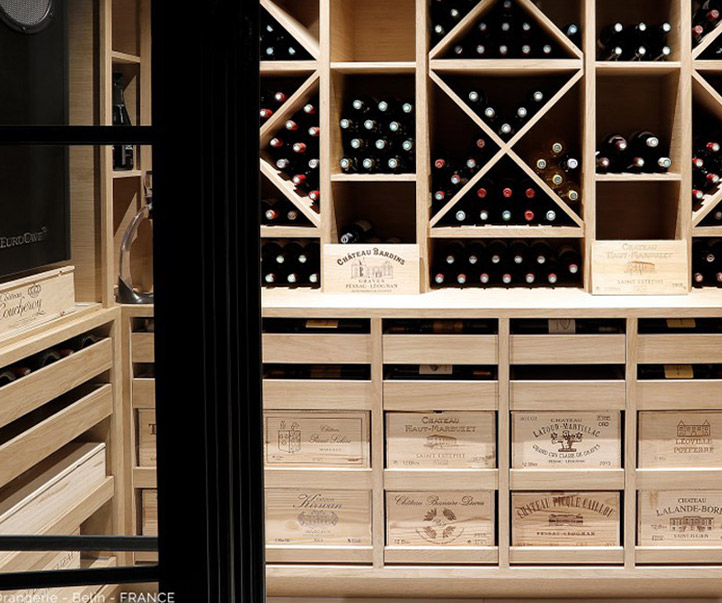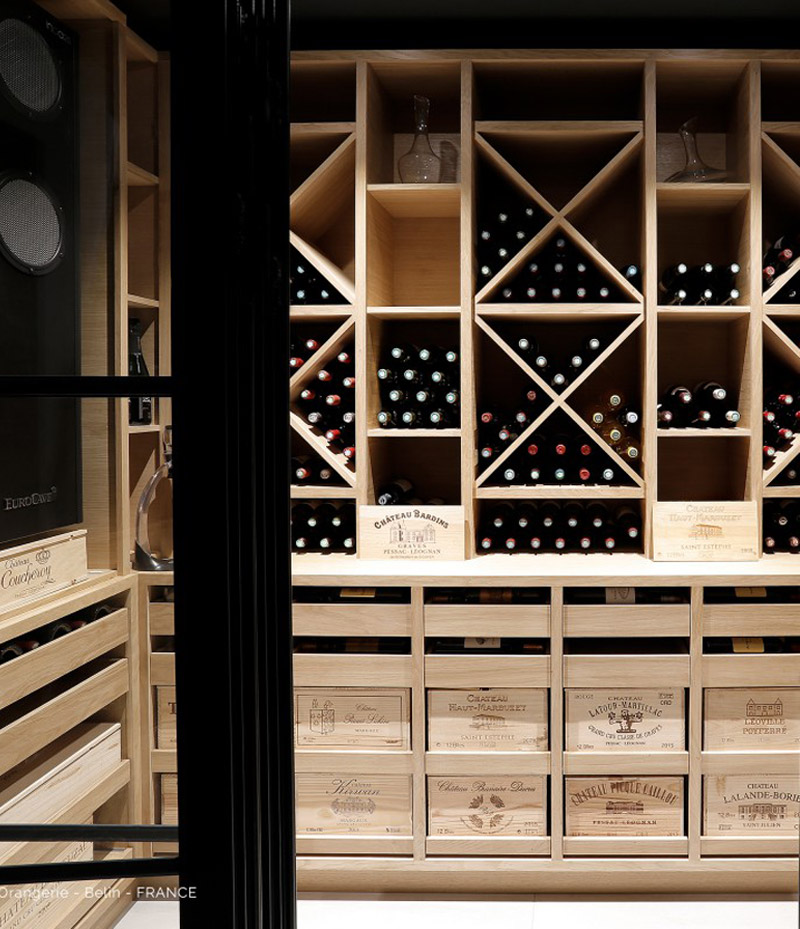
Wine cellar – All you need to know
If you are very interested in wines, a wine cellar is one of the greatest projects you can embark on. Your wines get an optimum aging environment, while you get a beautiful and nice room where you have plenty of space to organise and enjoy your best wines. Nevertheless building a wine cellar is a project that requires planning and preparation, which we will do our best to prepare you for in this article.
Once you have made a decision that you want to have a wine cellar you have a first big choice to make; are you going to build it yourself, or have it built by an external party? If you are practical there are obviously many parties that you can turn to for help without having to lift a finger yourself (Google or contact us for tips), and if you are handy it can be fun and economical to build it yourself. Regardless of this we hope this guide will help you to take the next step in your project.
This article is arranged in five sections, which are:
It is also worth thinking about whether you do want a wine cellar, or if you should invest in a wine cabinet instead, which is worth thinking about one more time before starting your wine cellar project.
1. Why should you have a wine cellar?
If you are interested in wine no further motivation is needed for this question, but above all the obvious purpose of a wine cellar is that the wine should be good, and therefore we can start by going through the basics of aging wine , since this forms the basis for how the wine cellar should be built.
There are five basic components to fulfil for a wine to age well:
- Cool and stable temperature of around 10 degrees
- Free from vibrations
- Humidity between 70-75%
- Odourless
- Free from direct sunlight
If the wine is aged in these conditions it will have its most optimal maturing process, and therefore the wine cellar will be built to fulfil these criteria. The first step in the process will be to find a suitable place.
2. Where should you have a wine cellar?
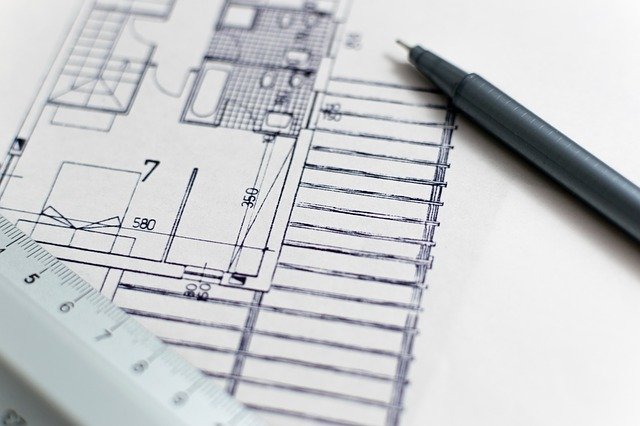
Finding a suitable place for a wine cellar obviously depends on your opportunities. If you are building a new house you have a lot to choose from, although most people are in the situation where they have to demolish a cloakroom, or rebuild a storeroom etc.
In practice it is often about finding a compromise between having fully optimal prerequisites for the wine and finding a suitable solution. Having your wine cellar under the stairs can be very nice, but since people go up and down the stairs it is not optimal from a vibration perspective. You quite simply have to decide what you think is most important.
As a wine cellar would imply, a cellar is in fact often a very good alternative because cellars are usually naturally cool and protected from light. But give it some good thought when thinking about where to locate the wine cellar. Some people are so creative that they rebuild an old sauna to make a wine cellar, since they get a lot of the preliminary work into the bargain. Only your imagination sets the limits.
Regardless of which room you choose there are above all two factors that you will need to take into consideration:
- That there is the possibility of exhaust air. Further on in this guide we will go through the different components that are needed in a wine cellar, and the essence of these components is the cooler. When the cooler is cooling it must have somewhere to press out the warm air that is “left over”. Outdoors is excellent, but a large adjacent room also works well. A small room such as a cloakroom or cleaning cupboard is not recommended, since the small space will quickly get hot and will impede the functionality of the cooler.
- That there is electricity. The cooler runs on electricity and therefore this is a must. You will probably also want to have a light in your wine cellar.
The above factors can be considered to be the only musts. You will also save on some of the running costs if you put your wine cellar in a place that is normally around 12 degrees, but this is a preference rather than a rule.
3. How big should a wine cellar be?
You should take into consideration the space that is actually available, but there are several other factors to think about to find your optimum size. If you have the privilege of being able to decide the size yourself, one tip is to design the wine cellar for at least twice the size of the collection of wines you have today. Your interest in wine is hardly going to diminish once you have a wine cellar, so it will be good to have some space.
On the other hand a large wine cellar needs more looking after. It needs a bigger cooler and better ventilation to ensure a uniform temperature. Apart from the actual construction there are also the running costs in the form of electricity, which nevertheless can be considered to be relatively low in this context.
Putting a figure on this is not easy, since every wine cellar is unique. As a general rule you could say that you need at least 3 square metres to have a collection of 500 bottles. If you want to have 1500 bottles you will need to go up to about 10 square metres. Take these figures as very general guidelines since the equation is obviously more complicated in reality. For example, the wall space is a lot more important than the floor space, and the way you arrange the interior fittings will also determine how many bottles you can find space for.
4. How do you build a wine cellar?
We will not go into exactly how to build a wine cellar, but we can list the steps you have to go through from start to finish.
- Think through the entire project from start to finish, and choose a room. Because you are reading this text you are apparently half way there, but it can be worth mentioning once again that planning and preparations will considerably improve the end result of your project. Measuring the temperature in the room (bear in mind fluctuations from summer to winter) gives you an idea of the size of cooler you will need.
- Insulate the room, both for moisture and the cold. How much insulation you need will depend a lot on your other prerequisites. A separate article could well be written on insulation and there are lots of different opinions on how insulation is best done, but in this article we have chosen not to go into insulation in depth and to focus on the general aspects instead.
- Make space for the cooler. Route cables for electricity and lighting.
- Put the interior fittings you have thought to have in place in the form of wine racks. There are a lot of opportunities for combinations here and we will be going through this in more detail in the next section.
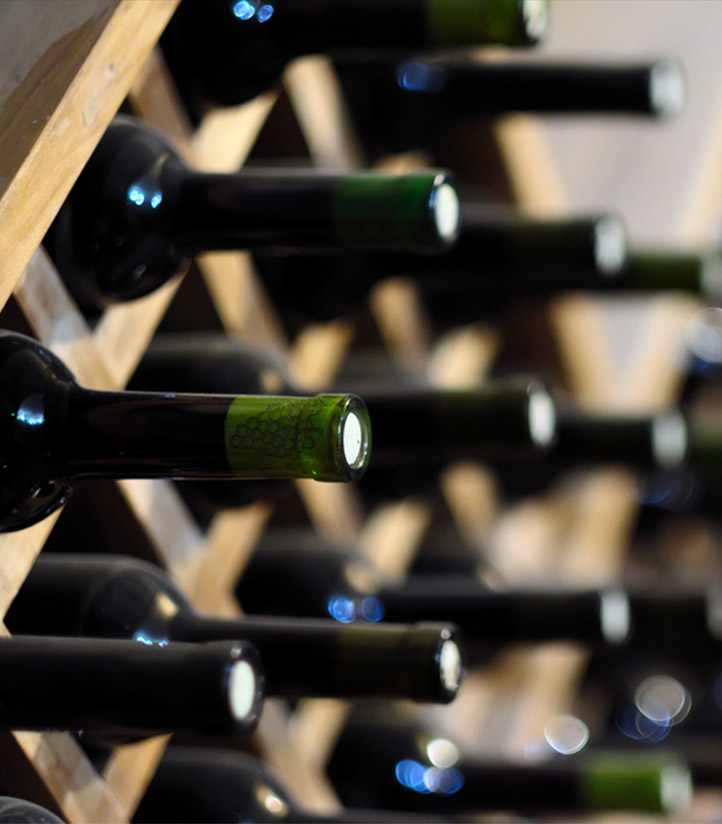
5. Which components are needed in a wine cellar?
A wine cellar actually consists of a small number of components and we will start with the most essential, namely the cooler.
Cooler
The basic principle for a cooler for a wine cellar is that it is the same as for other types of coolers for refrigerators, air conditioners or heat exchangers, i.e. cooling is achieved by transporting heat to another place. The design of specialised wine cellar coolers (as opposed to standard air conditioning) is, however, optimised to maintain a temperature of 10 degrees as effectively as possible without drying out the air too much. The humidity is an important parameter in a wine cellar (it should be between 50 and 80%), so check that the cooler you choose can also handle the humidity. There are basically two types of coolers to choose between: Through-the-wall cooler or split system.
The big difference between the two systems is that in a ventilated system the actual cooler is somewhere else and the air flows into the room through a ventilation tube. In other words it works in accordance with the same principle as central air conditioning in a house. The advantage for your wine cellar is that you do not need to have the cooler in the actual cellar, just intake air, although the installation is a lot more complicated and takes more energy to run.
In a system that is not based on ventilation the cooler is placed inside the wine cooler and therefore does not need any ventilation tubes, whereby the warm and cold parts of the cooler are linked together by refrigerant tubes, which are much smaller than ventilation tubes. This is much simpler and so the only reason to choose a ventilated system is to reduce the noise somewhat and to avoid the aesthetic impact of having the cooler in the actual wine cellar.
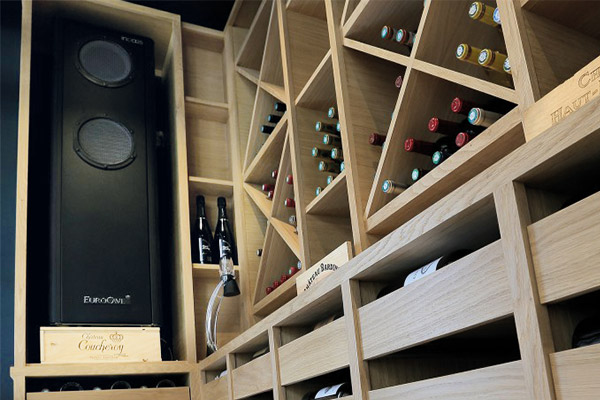
Split system
The basic principle for a split system is the same as for a through-the-wall cooler, with the difference that the cooler is divided into two parts. An evaporator part that emits cold air and a condenser part that in turn emits warm air, which are linked together with tubes for the refrigerant. You put the cold part in your wine cellar, the warm part where you want to have your exhaust air, and then put the tubes in between. (This is very similar to how a heat exchanger works.) A split system is a good solution if you do not have a directly adjacent room where you want to have the exhaust air. A split cooling system also has the advantage that is reduces the noise and vibrations in the actual wine cellar, in that the insert with the compressor stands in a different room. On the downside these systems are much more expensive than a simple cooler.
Split systems can in turn be divided into two types of systems, namely ducted or ductless systems).

Through-the-wall cooler
This is the simplest and cheapest solution for a cooler and is therefore also the most popular solution. It is quite simply a cooler that you put in the wall, so that one side goes into the wine cellar and the other side out to the room you want to move the warm air to. The cooler will generate cooling in the wine cellar and the corresponding amount of warmth to the outside.
There are coolers for different sizes of wine cellars, where the manufacturer often indicates how many square metres the cooler can cool. Note that the insulation in your wine cellar will be decisive for how much the cooler needs to work, you can save a lot of energy by having a well insulated room.
Door
The choice of door should not be underestimated, above all since you can waste a lot of energy if you choose the wrong door. Just as the walls, floor and roof need to insulated, so does the door to prevent it leaking too much warmth. Doors for indoor use are in general not well insulated, while outside doors generally are. There are also special doors made for wine cellars, which can be more aesthetically attractive than a normal outside door, even if they are functionally similar to an outside door.
Wine rack
The wine rack is the essence of the actual interior of the wine cellar and is obviously of central importance both functionally and in terms of appearance. There are almost an infinite number of ways in which you can fit out your wine cellar, but your first decision will be whether you want to go for a less expensive and more standardised solution, or a more expensive custom-made solution. A specially built solution (which means a joiner builds it from scratch) is obviously much more expensive, but gives you precisely the look you want to have.
If you choose instead to buy finished modules, there are a host of manufacturers to choose from. There are basically three different types of wine racks that are common in a wine cellar:

Cross shaped modules
This module is best described as a horizontal case with a cross in it. In this way bottles can be placed on each other in the compartments. This is a popular and nice solution if you want to have space for a relatively large number of bottles. The disadvantage is obviously that it is more difficult to take out an individual bottle. (There are cross solutions where the compartments have different sizes, and also for where each bottle has its own compartment.)
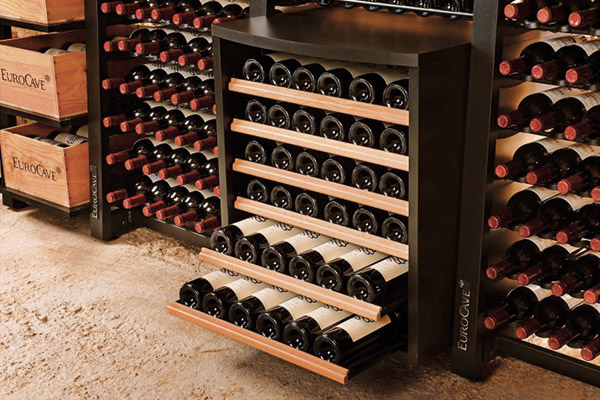
Individual stacking
Each wine bottle has its own compartment. The advantage of this is obviously the simplicity of easily taking out one bottle. The disadvantage is that it is not the most space-saving and that there are different sizes of bottles. A wine cellar often has a large number of these types of compartments.
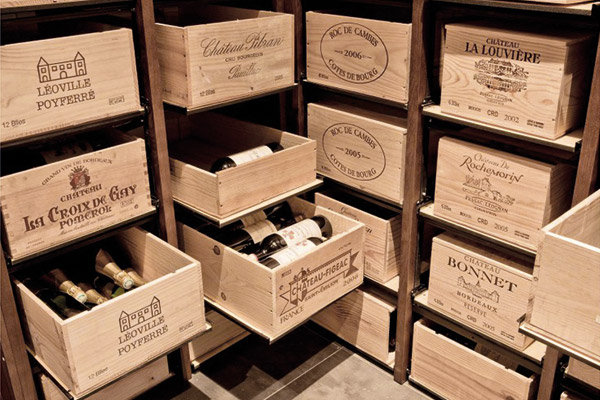
Case storage
Case storage involves compartments or shelves where you can store wines in their wine cases, which is optimal if you want to retain the actual cases.
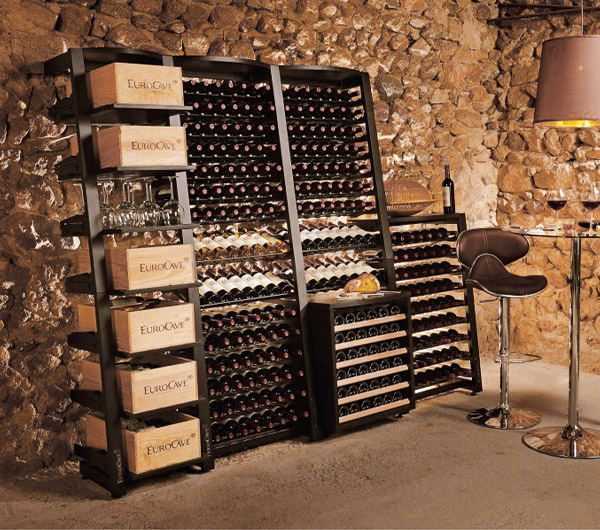
Usually a mix of different modules is what is most attractive and most effective in a wine cellar, and by searching Google you can find lots of inspiration.
Some other points are worth thinking about when it comes to wine racks:
- Which type of wood should I use? The most important thing is that the wood you use does not mould or emit odour. Common materials for wine racks are oak or pine, while more exclusive racks are made from mahogany or walnut.
- Note that there is a big difference in size between different types of bottles. Choose somewhat different types of storage modules for this reason. Most types of bottles, even champagne (not magnum bottles), can manage with a hole that is 10 cm, whereby this is good guideline.
Last, but not least…
Do you need to follow all these tips to the letter?
Of course not, the most important thing is that you get a solution that you are pleased with. Perhaps you have limited space, perhaps you prioritise being able to see your bottles, that they are fully protected from sunlight, and perhaps that you do not want to invest in a cooler. You decide what suits you best, and if you should have any queries, viewpoints or thoughts you are naturally more than welcome to contact us.
Design tips:
- Many wine cellars look good by having natural materials. Think stone, brick and wood. You can also have a plant, some wine accessories or pictures to enhance the feeling.
- A cooler is often not very pretty, so if you can conceal it in the structure it would be preferable. The priority of course is that it sits in a functional place.
- The lighting can radically enhance the experience of a wine cellar. Dimmable spotlights in the right place will do wonders for your wine cellar.
General tips:
- Take into account that your wine is liable to be stolen. There are doors with locks, but depending on the position of the wine cellar there can be other ways of getting in, such as a window.
- All wine is stored at the same temperature. But if you want to have a few bottles ready at serving temperature you can add a small 2-zone wine cooler in the kitchen.
- And finally, don’t forget to also drink your wine! Storage is the journey, drinking it up is the goal!

